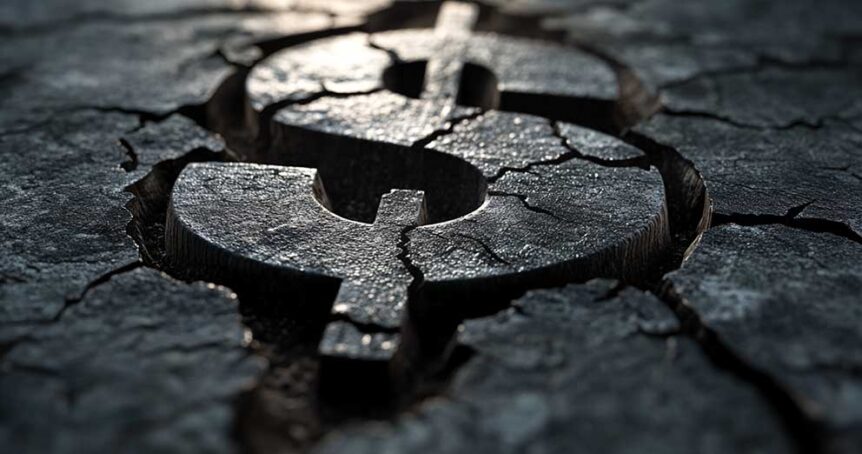The U.S. dollar has long been the backbone of the global financial system, but rising national debt, inflation, and geopolitical pressures threaten its dominance. A potential dollar collapse, while rare, could lead to massive disruptions worldwide. Preparing for such an event is critical for safeguarding your wealth and securing your financial future. In this article, we’ll discuss how to prepare for a collapse, with strategies to mitigate risks and protect your assets.
| Key Takeaways |
|---|
| Diversifying your investment portfolio, including assets like precious metals, is essential to prepare for a dollar collapse and protect against economic instability. |
| Interest rates play a key role in influencing inflation, so monitoring these trends can help protect your wealth. |
| Real estate and tangible assets like gold coins offer stability during an economic collapse by maintaining value. |
| Precious metals are seen as a good hedge against the fall of the US dollar. |
| Financial institutions and foreign investors will be significantly impacted by global shifts if the dollar collapses. |
What is a Dollar Collapse?
A collapse happens when the value of the U.S. dollar falls sharply against other major fiat currencies, like the euro or yen. While the dollar is currently the world’s reserve currency, a collapse could result from mounting national debt, hyperinflation, or the efforts of countries like China and Russia to shift away from using the dollar in global trade. Countries like Argentina and Venezuela have experienced similar currency crises, which led to skyrocketing inflation and widespread financial hardship.
If the dollar were to collapse, the global economy would face huge disruptions. The ripple effects would be felt worldwide, especially in international trade and financial markets.

Start buying precious metals at cost.
World Economy and Global Repercussions of a Dollar Collapse
A collapse of the U.S. dollar would have far-reaching effects on the world economy, as the dollar is deeply integrated into international trade, finance, and global markets. Many countries hold their reserves in dollar-denominated assets, and the U.S. dollar serves as the primary currency for commodities like oil, gold, and other raw materials. If the dollar collapses, the global financial system would be thrown into chaos, with major disruptions in international trade and investment.
Countries heavily reliant on the dollar, especially those that peg their currencies to it or conduct most of their international trade in dollars, would face severe economic consequences. Foreign investors may lose confidence in dollar-backed assets, leading to a sharp decline in investments in U.S. markets, and potentially causing a cascade of currency crises across other nations. In response, other currencies, such as the euro, the Japanese yen, or even the Chinese yuan, could strengthen as countries seek safer alternatives to the dollar.
Physical assets like precious metals and real estate investments would gain prominence in global portfolios as investors look for tangible assets that retain value during periods of currency instability. Physical gold would likely become an even more important safe haven for governments and central banks, especially as they shift reserves away from the dollar to diversify and protect their wealth from further devaluation.
Additionally, national debt concerns would escalate, as many countries hold U.S. debt in their portfolios. A devalued dollar would lead to a loss of value in these holdings, potentially triggering a global debt crisis. The Federal Reserve would face enormous pressure to stabilize the situation, but with limited tools in the case of a full-blown currency collapse.
Preserving the Dollar’s Purchasing Power
The dollar’s purchasing power has been steadily eroding due to inflation over the past century. The pace of decline has accelerated in recent years. Protecting your wealth from further depreciation means investing in assets that are less vulnerable to inflation. One way to do this is by holding hard assets, like gold, silver, and real estate, which tend to maintain or increase in value when inflation rises.
Inflation increases the cost of goods and services, effectively reducing the value of your savings. By diversifying into inflation-resistant assets, you can prevent your purchasing power from shrinking even more.
How to Prepare for Dollar Collapse: Key Strategies
One of the smartest ways to prepare is to diversify your investments. By spreading your assets across different classes, you can protect yourself from the fallout of any single currency’s failure. In this section, we’ll explore the most important strategies to help safeguard your wealth.
Asset Classes to Consider During A Collapse
To protect your wealth, it’s crucial to consider assets that hold or increase in value during times of economic instability.
Precious Metals (Gold, Silver, and Platinum)
Gold and silver have always been considered safe-haven assets during periods of economic crisis. Unlike fiat currencies, precious metals can’t be printed or inflated, making them a reliable way to preserve wealth when paper money loses value. Gold, in particular, has been a store of value for centuries, while silver has the added appeal of being widely used in industries. OWNx makes it simple to access and invest in precious metals, providing a secure and accessible platform that allows you to add tangible assets to your portfolio or retirement account.
Gold IRAs are a great option to add precious metals to your retirement portfolio. They allow you to hold physical gold in a tax-advantaged account, protecting your savings from a devaluing dollar. OWNx’s Gold IRA services streamline the process of adding physical gold to your retirement account, offering expert support, secure storage, and tax advantages. With OWNx, diversifying with precious metals becomes an accessible strategy, helping you maintain purchasing power even when traditional currencies falter.
Cryptocurrencies
Cryptocurrencies like Bitcoin are becoming a popular alternative to traditional currencies. Their decentralized nature makes them less vulnerable to government interference or economic crises. Bitcoin, often called “digital gold,” shares key traits with precious metals, like scarcity and resistance to inflation.
That said, cryptocurrencies are highly volatile, which makes them riskier than more established assets. It’s smart to limit your exposure to this market by only investing a small portion of your portfolio.
Real Estate
Real estate stands out as a valuable investment during times of economic turmoil, particularly when the dollar’s purchasing power starts to decline. When the dollar weakens, property values generally rise, making real estate a smart hedge against inflation. The appeal of real estate lies in its dual benefits: not only does it offer the potential for capital appreciation, but it also provides a consistent stream of income, particularly through rental properties.
In the event of a collapse, real estate investors would likely see the value of their holdings increase, as tangible assets like property tend to retain or even grow in value during inflationary periods. Investing in U.S. real estate is one way to hedge against a declining dollar, but savvy investors might also look into foreign real estate as part of their diversification strategy. Foreign properties offer protection against a devalued dollar by being linked to a different currency and market. By owning real estate in countries with stronger currencies or more stable economies, you can further shield your wealth from the impact of a collapsing dollar.
However, it’s important to note that real estate isn’t for everyone. It requires substantial capital, and it’s not as liquid as other investments. When you own property, it can take months to sell it and convert it into cash, which might not be ideal if you need quick access to funds. Additionally, managing real estate, especially in foreign countries, comes with its own set of challenges, such as navigating local property laws, dealing with property management, and handling tax issues. Real estate can be a powerful tool in preparing for a dollar collapse, but only if you have the time, capital, and knowledge to manage it effectively.
Maintaining Liquidity: Building an Emergency Fund
In any financial crisis, liquidity is key. Having cash reserves that can cover essential expenses for 6-12 months is critical. Even though physical assets like gold or real estate are important for long-term protection, having liquid funds gives you the flexibility to handle short-term challenges during a dollar collapse.
Consider building your emergency fund using high-yield savings accounts or money market funds, which offer immediate access to cash while also earning some interest. Physical storage of essential items like food and water is another practical step. Stocking up on non-perishable food and keeping a supply of clean water can help you navigate potential shortages during times of crisis.
Preparing for Economic Uncertainty and High Inflation
High inflation often accompanies a dollar collapse, and being prepared for it is essential. Rising inflation means higher prices for everyday goods and services, further eroding the value of your savings. This is why it’s vital to position your portfolio with assets that can withstand inflationary pressure, such as gold, real estate, and even foreign stocks.
Managing debt is also crucial. Paying down high-interest debt improves your financial stability, allowing you to preserve more of your income when the cost of living rises. By reducing your monthly expenses and keeping spending in check, you free up more funds for essential savings and investments.
Monitoring Economic Trends
Keeping an eye on economic indicators can help you stay ahead of a dollar collapse. Watch for signs such as rising inflation, changes in interest rates, and fluctuations in the US Dollar Index. The dollar’s value against other currencies can provide insights into its strength. Additionally, geopolitical events often have a significant impact on currency stability and global trade.
By staying informed and regularly reviewing your portfolio, you’ll be able to adjust your strategies to protect your wealth as economic conditions shift.
The Ultimate Hedge: Infinite Banking and Personal Banking Systems
For a more unconventional but powerful strategy, some turn to infinite banking. This concept, also known as becoming your own banker, involves using specially designed whole life insurance policies to build a personal banking system.
Here’s how it works: you overfund a whole life policy to build up its cash value. Once this value grows, you can borrow against it while the policy continues to earn interest. The money borrowed can be used for anything you like, and since you’re borrowing from your own policy, you can set the repayment terms yourself. This strategy allows you to continue earning uninterrupted interest while having access to cash.
In a scenario where the dollar collapses, infinite banking offers a way to preserve and grow your wealth. Since the system operates outside of traditional banks, you avoid many of the risks associated with inflation or currency devaluation. Plus, the policy provides lifelong protection, giving you peace of mind during turbulent times.
Conclusion
In a world of economic uncertainty, preparing for a collapsing dollar is all about diversification. By spreading your assets across different classes—such as precious metals, real estate, and even cryptocurrencies—you can protect your wealth from the fallout of a collapsing dollar. Monitoring economic trends and adjusting your strategies accordingly are key to staying financially resilient.
OWNx offers a secure, accessible platform for investing in precious metals, helping you diversify your portfolio with assets that have stood the test of time. Whether it’s purchasing silver, setting up a Gold IRA, or adding physical gold to your retirement savings, OWNx provides a range of options to tap into the enduring stability of precious metals. Adding these assets can help ensure that you are prepared for whatever the future holds.
Take control of your financial future by staying informed and diversifying your investments with OWNx to weather any storm.

Start buying precious metals at cost.
FAQs
If the US dollar collapses, its value would plummet, leading to hyperinflation, reduced purchasing power, and widespread disruptions in the global economy, especially in countries reliant on dollar-based trade.
Other currencies often strengthen as global investors shift toward safer alternatives, benefiting economies with strong currencies while weakening the demand for the US dollar.
Rising interest rates increase borrowing costs, slowing down economic growth, which could accelerate a financial crisis or deepen an economic collapse as debt becomes more expensive to manage.
The Dollar Index measures the value of the US dollar against a basket of currencies, offering insight into its strength relative to other fiat currencies during a crisis and guiding investment decisions.
Yes, a collapse of the fiat currency system, particularly the US dollar, would have global repercussions, severely impacting international trade and destabilizing economies that rely on dollar reserves.
Physical assets like precious metals act as safe havens during a collapse, retaining value when paper currencies devalue and providing protection against inflation and currency volatility.
High national debt increases the risk of the dollar collapsing by eroding confidence in the U.S. government’s ability to meet its obligations, leading to potential devaluation and economic instability.
Exchange traded funds (ETFs) focused on precious metals or foreign assets can offer protection during currency crises, providing diversification away from dollar-dependent investments.
If the dollar collapsed, the value of real estate investments would likely increase, as property tends to appreciate during inflation, providing a stable physical asset to protect wealth during economic downturns.
